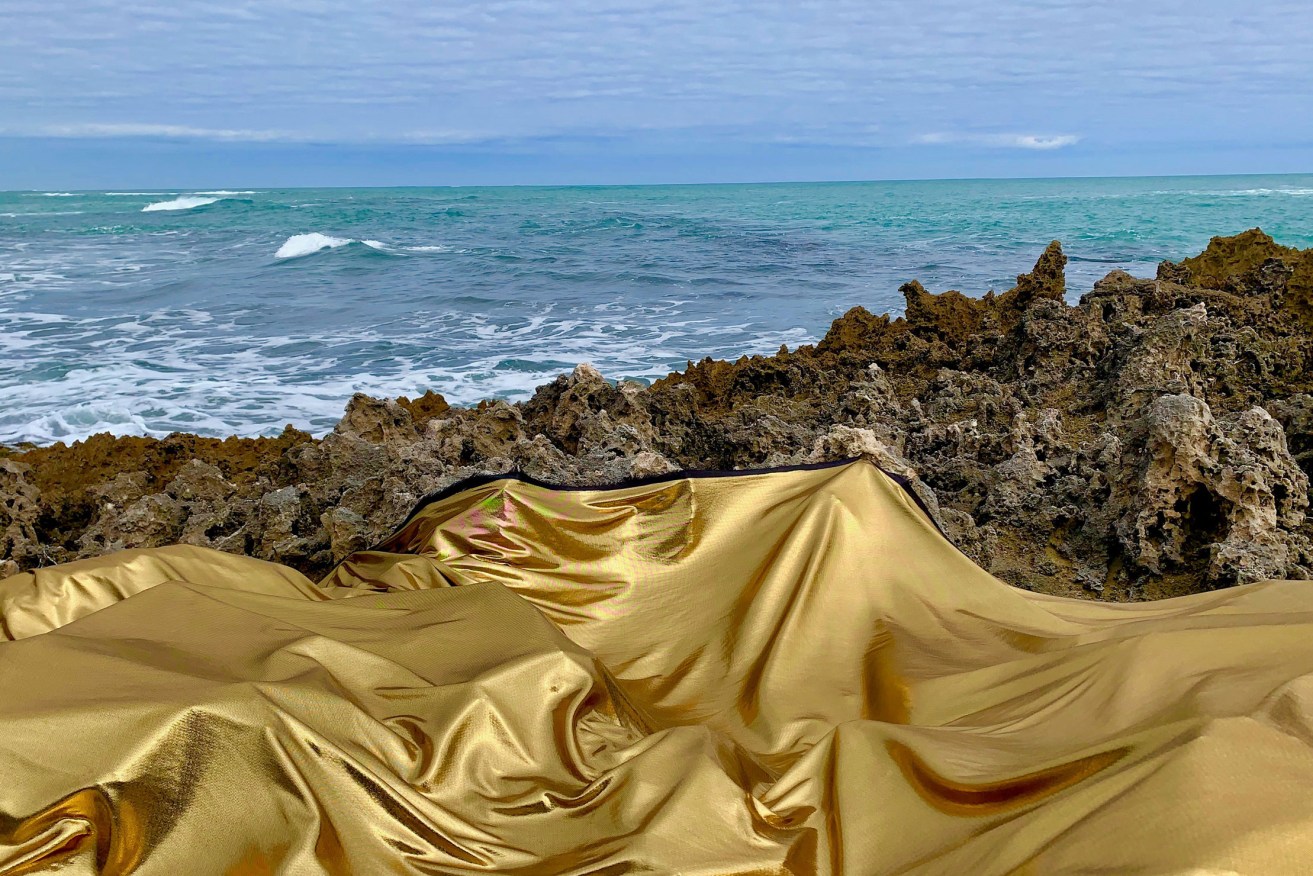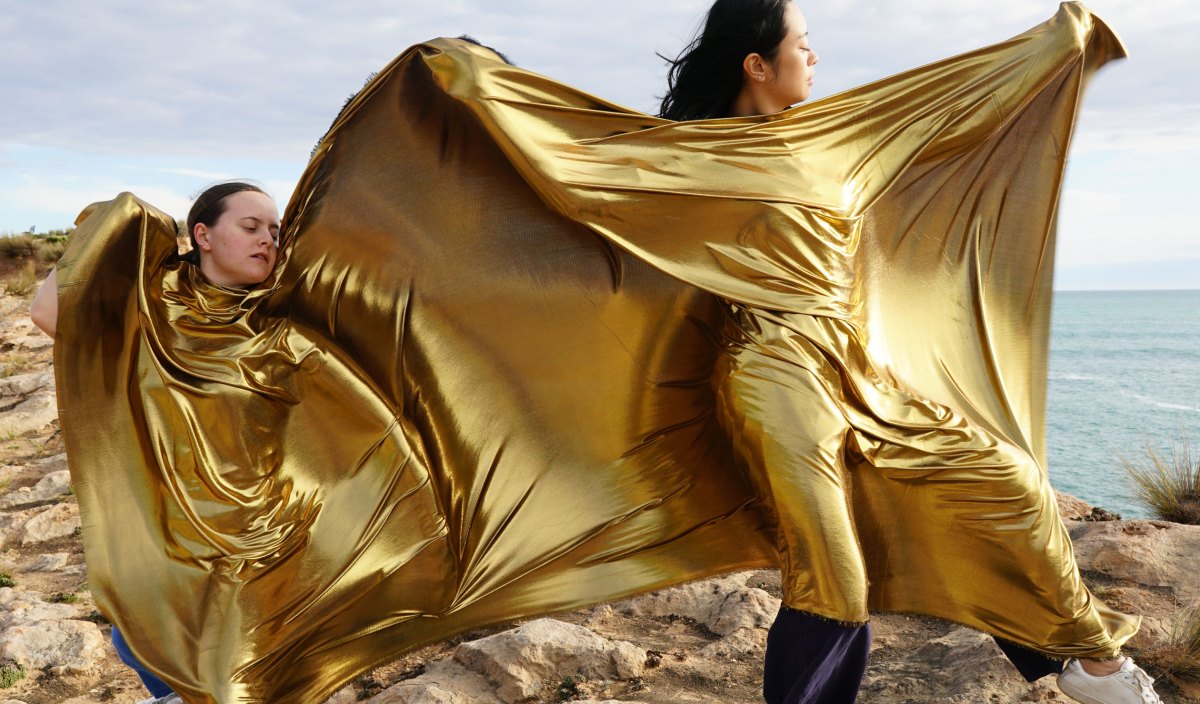OzAsia review: The Long Walk
Twenty-first-century technology opens breathtaking new perspectives on the historic, 500km march from Robe to the Victorian goldfields endured by 16,000 Chinese miners seeking a better fortune.


'The Long Walk' captures the rugged cliffs and seascapes of the Robe coastline. Photo: Sue Healey
The first Chinese miners landed at Robe 166 years ago. The Chinese Immigration Act of the 1850s had made official Australian ports hostile, and determined to make their way to the Victorian goldfields, they landed on the beaches along Robe’s coastline, boosting the town’s economy as they bought the supplies that would sustain them on the journey ahead.
Director and choreographer Sue Healey was to introduce this livestreamed, world premiere event from the exact location where the miners first landed, but as if in reminder of the unpredictability of the overpowering forces of nature the miners faced on their arduous journey, technology loses out against wild weather.
We catch a brief glimpse of Healey standing, windswept and mouthing silent words, in front of the vermillion Chinese Welcome Gate erected on the sand where the miners first set foot on land; there’s no sound, and then, in a heart-stopping moment, the screen goes black. But this doesn’t last long. When the screen flickers back to life, we find ourselves flying along with a drone in a vertiginous swoop past rugged cliffs, through rock arches, skimming the waves at high-speed with a birds-eye view of the majestic expanse of sea and landscape.
There are soft gasps from the audience, and the technology glitch is instantly forgotten.
A switch to a land-based camera closes in on dancers Kimball Wong, Julian Renlong Wong, Kō Yamada, Tayla Hoadley and Queenie Wu, all dressed in traditional, crimson Tangzhuang-collared jacket and trousers.
From above, we watch Wong roll and writhe in that in-between place between sea and land, inscribing arabesques into the wet sand as waves beat upon the shore; a land-based view shows another dancer walking from waves onto sand, filmed in reverse, clothing dry, a rod and two baskets on her shoulders. Another dips and sifts with a basket on a rod which he then spins, jabs and rotates in martial arts fashion, as if ready for the battle ahead. A fourth dancer perches on craggy rocks, a shell in one hand and a water-worn piece of blue and white porcelain in the other; she circles them around her face, her hair, hiding one eye with the fragment of blue and white mirroring the blue and white-cloud sky behind her, the crimson of her clothes contrasting with azure in a moment of exquisite beauty.
The group choreography is often shot by drone in vertiginous upwards swoops, the bright red of the dancers seen from above in patterns, their movements mirrored by their shadows cast by the angling sun. The dancers’ movements continually respond to the environment around them as they stumble and struggle along deeply trenched sand paths, or balance precariously, yet in control, on sharp rocks.
The birds-eye view of the choreography feels unique, framing the dancers, now tiny, vulnerable pops of bright red against a vast and seemingly barren sand-grey moonscape. It’s dance as we’ve never seen it before, and it’s transfixing.

Dancers Tayla Hoadley and Queenie Wu on location at Robe ahead of the premiere of The Long Walk at OzAsia Festival. Photo: Sue Healey
The score integrates the whole with a call and response between dancers, musician, director, drone pilot and landscape. It is composed by internationally-renowned musician Ben Walsh, who we see sitting on clifftop rocks with a microphone and various objects he uses as percussion. He beats two palm-sized rocks together in melodic syncopation, raps on metal bowls that sound like a small luo gong, or a blue plastic drum skinned with rubber sheeting – found objects, as if to reflect the resourcefulness of the miners as they made their way towards promised fortunes.
As the score builds and swells, Walsh plays a series of electronic drums, building a driving rhythm as if in reflection of the tenacious placing of one foot in front of the other on the 500km walk, and a nod to the way the performance marries technology with history.
Two dancers, playful, buffet gold balloons spelling G O L D as they roll around the earth; later, all five dancers are seen from high in the sky, arranged like the petals of a flower, holding bright red rods that mark patterns in the sand. They dance with their shadows as they arrange themselves and the rods in formations that eventually come to spell 金, the Chinese character for gold.
It’s only once the performance ends that OzAsia artistic director Annette Shun Wah explains the circumstances that meant a video pre-recorded as back-up had to be screened instead of the live footage; the drones and rocks had been made hazardous by the gales and the rain. We were then treated to an additional screening of Healey’s 2018 work Weerewa, and none of the glitches mattered. Watching The Long Walk was a rare and unforgettable experience, and just as thrilling as a live performance would have been.
When Shun Wah told us of the fateful discovery in the sand by Kimball Wong, during a recent rehearsal, of that wave-worn piece of Chinese porcelain – since authenticated and considered likely to have come from one of those first ships carrying the miners across the seas – it felt as though fate had played a hand. That small, beautiful fragment connected past and present, as if those miners still walked and battled with the landscape on their long walk towards new lives.
The Long Walk was presented as part of the 2022 OzAsia Festival, which continues until November 6.
Read more OzAsia stories and reviews here.




